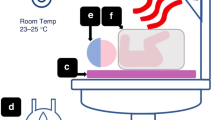Abstract
Two newborns at high risk for severe encephalopathy were passively cooled by discontinuing the supplied heat from a radiant warmer. Cooling was attempted in both babies (successfully in one) before the arrival of the neonatal transport team. Both infants had core temperatures of approximately 34°C on arrival at the NICU. Passive cooling may be an effective method to initiate cooling very early in the course of encephalopathy.
This is a preview of subscription content, access via your institution
Access options
Subscribe to this journal
Receive 12 print issues and online access
$259.00 per year
only $21.58 per issue
Buy this article
- Purchase on Springer Link
- Instant access to full article PDF
Prices may be subject to local taxes which are calculated during checkout

Similar content being viewed by others
References
Eicher DJ, Wagner CL, Katikaneni LP, Hulsey TC, Bass WT, Kaufman DA et al. Moderate hypothermia in neonatal encephalopathy: efficacy outcomes. Pediatr Neurol 2005; 32: 11–17.
Gluckman PD, Wyatt JS, Azzopardi D, Ballard R, Edwards AD, Ferriero DM et al. Selective head cooling with mild systemic hypothermia after neonatal encephalopathy: multicentre randomised trial. Lancet 2005; 365: 663–670.
Shankaran S, Laptook AR, Ehrenkranz RA, Tyson JE, McDonald SA, Donovan EF et al. Whole-body hypothermia for neonates with hypoxic-ischemic encephalopathy. N Engl J Med 2005; 353: 1574–1584.
Whole body hypothermia for the treatment of perinatal asphyxial encephalopathy, http://www.npeu.ox.ac.uk/toby/index.php.
Thoresen M, Penrice J, Lorek A, Cady EB, Wylezinska M, Kirkbride V et al. Mild hypothermia after severe transient hypoxia ischemia ameliorates delayed cerebral energy failure in the newborn piglet. Pediatr Res 1995; 37: 667–670.
Burnard ED, Cross KW . Rectal temperature in the newborn after birth asphyxia. BMJ 1958; 2: 1197–1199.
Brück K . Temperature regulation in the newborn infant. Biol Neonate 1961; 3: 65–121.
Plattner O, Semsroth M, Sessler DI, Papousek A, Klasen C, Wagner O . Lack of nonshivering thermogenesis in infants anesthetized with fentanyl and propofol. Anesthesiology 1997; 86: 772–777.
Acknowledgements
There was no financial support for this project.
Author information
Authors and Affiliations
Corresponding author
Rights and permissions
About this article
Cite this article
Anderson, M., Longhofer, T., Phillips, W. et al. Passive cooling to initiate hypothermia for transported encephalopathic newborns. J Perinatol 27, 592–593 (2007). https://doi.org/10.1038/sj.jp.7211781
Received:
Accepted:
Published:
Issue Date:
DOI: https://doi.org/10.1038/sj.jp.7211781
Keywords
This article is cited by
-
Theoretical basis for the use of non-invasive thermal measurements to assess the brain injury in newborns undergoing therapeutic hypothermia
Scientific Reports (2020)
-
Prevention of excessive hypothermia in infants with hypoxic ischemic encephalopathy prior to admission to a quaternary care center: a neonatal outreach educational project
Journal of Perinatology (2019)
-
Passive therapeutic hypothermia during ambulance and helicopter secondary neonatal transport in neonates with hypoxic brain injury: a 10-year retrospective survey
Child's Nervous System (2018)
-
Passive cooling during transport of asphyxiated term newborns
Journal of Perinatology (2013)
-
Therapeutic hypothermia on neonatal transport: 4-year experience in a single NICU
Journal of Perinatology (2010)



